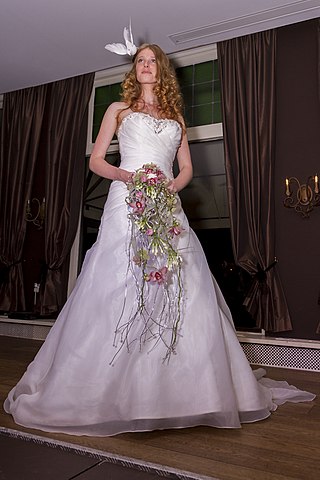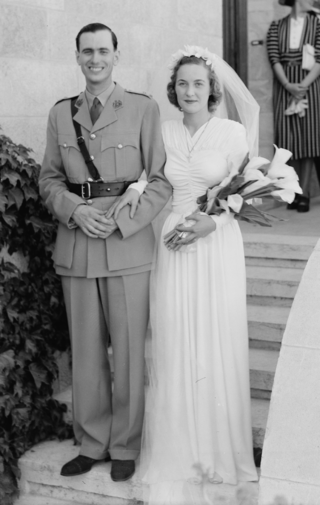
A wedding is a ceremony where two people are united in marriage. Wedding traditions and customs vary greatly between cultures, ethnicities, races, religions, denominations, countries, social classes, and sexual orientations. Most wedding ceremonies involve an exchange of marriage vows by a couple, presentation of a gift, and a public proclamation of marriage by an authority figure or celebrant. Special wedding garments are often worn, and the ceremony is sometimes followed by a wedding reception. Music, poetry, prayers, or readings from religious texts or literature are also commonly incorporated into the ceremony, as well as superstitious customs.
A white wedding is a traditional formal or semi-formal wedding originating in Great Britain.

An engagement or betrothal is the period of time between the declaration of acceptance of a marriage proposal and the marriage itself. During this period, a couple is said to be fiancés, 'betrothed', 'intended', 'affianced', 'engaged to be married', or simply 'engaged'. Future brides and grooms may be called fiancée (feminine) or fiancé (masculine), 'the betrothed', a 'wife-to-be' or 'husband-to-be', respectively. The duration of the courtship varies vastly, and is largely dependent on cultural norms or upon the agreement of the parties involved.

A veil is an article of clothing or hanging cloth that is intended to cover some part of the head or face, or an object of some significance. Veiling has a long history in European, Asian, and African societies. The practice has been prominent in different forms in Judaism, Christianity, and Islam. The practice of veiling is especially associated with women and sacred objects, though in some cultures, it is men, rather than women, who are expected to wear a veil. Besides its enduring religious significance, veiling continues to play a role in some modern secular contexts, such as wedding customs.

A wedding ring or wedding band is a finger ring that indicates that its wearer is married. It is usually forged from metal, traditionally gold or another precious metal. Rings were used in ancient Rome during marriage.

A wedding dress or bridal gown is the dress worn by the bride during a wedding ceremony. The color, style and ceremonial importance of the gown can depend on the religion and culture of the wedding participants. In Western culture, the wedding dress is most commonly white, a fashion made popular by Queen Victoria when she married in 1840. In Eastern cultures, brides often choose red to symbolize auspiciousness.

The traditional Vietnamese wedding is one of the most important ceremonies in Vietnamese culture, which is influenced by Confucian and Buddhist ideologies.

Marriage in Pakistan pertains to wedding traditions established and adhered by Pakistani men and women. Despite their local and regional variations, marriages in Pakistan generally follow Islamic marital jurisprudence. Marriages are not only seen as a union between a husband and a wife, but also an alliance between their respective families. These traditions extend to other countries around in the world where Overseas Pakistani communities exist.

Punjabi wedding traditions are a strong reflection of Punjabi culture with ritual, song, dance, food, and dress that have evolved over centuries.
In the United States and Canada, weddings follow traditions often based on religion, culture, and social norms. Most wedding traditions in the United States and Canada were assimilated from other, generally European, countries. Marriages in the U.S. and Canada are typically arranged by the participants and ceremonies may either be religious or civil.

Indian wedding clothes are elaborate set of clothes worn by the bride, bridegroom, relatives & other guests attending the wedding.

Traditional marriage customs in the Philippines and Filipino wedding practices pertain to the characteristics of marriage and wedding traditions established and adhered by them Filipino men and women in the Philippines after a period of adoption courtship and engagement. These traditions extend to other countries around the world where Filipino communities exist. Kasalan is the Filipino word for "wedding", while its root word – kasal – means "marriage". The present-day character of marriages and weddings in the Philippines were primarily influenced by the permutation of Christian, both Catholic and Protestant, Hindu, Islam, Chinese, Spanish, and American models.
Attire of Mangalorean Catholics refers to the traditional clothing of the Mangalorean Catholics from the Mangalore Diocese on the southwestern coast of India.

A bridegroom is a man who is about to be married or who is newlywed. In some circles, it is a modern alternative to bride or groom.
Bahaghara is a wedding ceremony performed by Odia Hindu people in the Indian state of Odisha. There are subtle differences in the rites observed by different castes. In Odia marriage rituals, the mother of the bridegroom does not take part in the ceremony. The Utkala Brahmins have their weddings only in the daytime, preferably at midday or in the morning, while the other caste weddings are done during the evening or night. There is the custom of sending betel nuts to family friends for inviting them to the marriage. The first invitation is sent to the family deity as a respect to the lord. Marriages in Odisha are mostly fixed and arranged by the parents. Marriages for serving or capturing is not common.

A wedding is a celebratory ceremony where two people are brought together in matrimony. Wedding traditions and customs differ across cultures, countries, religions, and societies in terms of how a marriage is celebrated, but are strongly symbolic, and often have roots in superstitions for what makes a lucky or unlucky marriage. Superstition is often linked to practices involving luck, fate or prophecy, and while many weddings are now more focused on celebratory traditions, many are still practiced, and numerous well-known wedding traditions have roots in superstitions from previous ages. A common example of a superstition involves no one seeing the bride in her wedding dress until the ceremony.

Weddings in ancient Rome were a sacred ritual involving many religious practices. In order for the wedding to take place the bride and the groom or their fathers needed to consent to the wedding. Generally, the wedding would take place in June due to the god Juno. Weddings would never take place on days that were considered unlucky. During the wedding the groom would pretend to kidnap the bride. This was done to convince the household guardians, or lares, that the bride did not go willingly. Afterwards, the bride and the groom had their first sexual experiences on a couch called a lectus. In a Roman wedding both sexes had to wear specific clothing. Boys had to wear the toga virilis while the bride to wear a wreath, a veil, a yellow hairnet, chaplets of roses, sex crines, and the hasta caelibaris. All of the guests would wear the same clothes as the groom and the bride. The Romans believed that if bad omens showed up during a wedding it would indicate the couple was evil or unlucky. In order for a marriage to be successful there needed to be no evil omens and everyone must follow the traditional customs.

A honggaitou, also shortened to gaitou and referred to as red veil in English, is a traditional red-coloured bridal veil worn by the Han Chinese brides to cover their faces on their wedding ceremony before their wedding night. The honggaitou is worn along with a red wedding dress. Veils have been used in China since the Han dynasty. The custom of wearing the honggaitou for wedding ceremonies can be traced back to the Song dynasty period. The custom of wearing the honggaitou, along with the traditional red wedding dress, continues to be practiced in modern-day China. However, under the influence of Western culture and globalization, most Chinese brides nowadays wear white wedding dresses and a white veil, an imitation of Western Christian weddings, instead of the red wedding dresses and honggaitou.

The nuptial veil, which is also referred to as the care cloth, carde clothe or wedding canopy, is an ancient Christian wedding tradition where a cloth is held over the heads of the bride and groom during the Nuptial Blessing. Symbolizing the "marriage yoke joining the bride and groom together", it is a rectangular linen or silk sheet smaller than the analogous Chuppah of Judaism, typically featuring a red pattern or a red cord, and is white in color. St. Isidore of Seville explained that the white represents the purity of Christian and marital love, while the red signifies the continuation of the family bloodline.


























